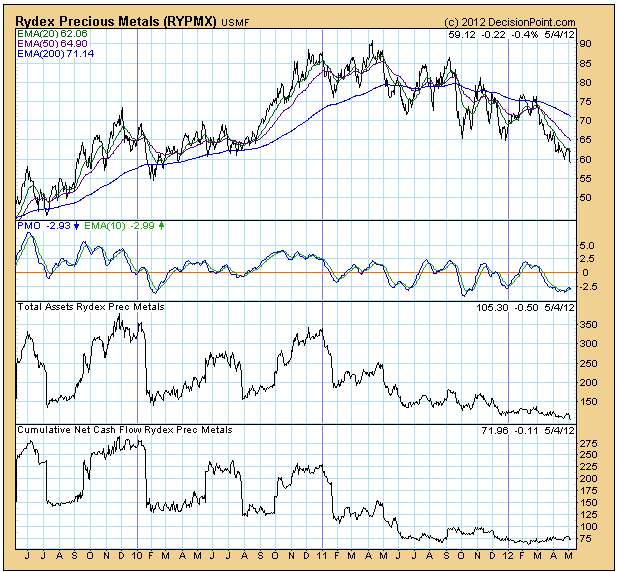Rydex Money Market Fund Assets Low Free Weekly Technical Analysis Chart McClellan Financial
Post on: 12 Июнь, 2015 No Comment

Free Chart In Focus email
Privacy. We don’t blitz you with marketing or share your email.
We have been watching the asset levels in various Rydex mutual funds since the mid-1990s as a useful sentiment tool. Rydex was a pioneer in offering open-end mutual funds designed for market timers, and the company initiated the practice of publishing the daily totals for how much money was invested in each fund. Fellow newsletter writer Steve Todd was the first to notice that these data could be used as a sentiment gauge, and now many others have taken up this practice.
Right now, we are seeing really low asset levels in the Rydex Government Money Market Fund (RYFXX). This means that the investors who keep their money domiciled at Rydex have largely pulled out of the safety of cash in order to put that money to work in the various other funds at Rydex.
Historically, low Money Market Fund asset values have been associated with the bullish sentiment extremes of important market tops. And similarly, high asset levels in this fund are an indication of safety-seeking investor behavior which is typical of an important bottom.
There are a couple of noteworthy exceptions highlighted in the chart. Back in 2012, we were really puzzled by a high Money Market Fund asset level seeming to coincide with a market top. It is not supposed to work that way, and it really threw us for an analytical loop. Then it was revealed that the owners of Guggenheim Investments (now the parent company of Rydex) had purchased the Los Angeles Dodgers baseball team, and that the spike in Money Market Fund assets was just their way of storing up the cash that was needed for that purchase. After the deal was done, the relationship got back to normal.
Another anomaly was in early 2013, when Money Market Fund assets dropped to a low level but the market kept on rising. Credit the Fed and its $85 billion of bond purchases each month for providing the fuel for that uptrend. That creates an ongoing interpretational quandary: does sentiment just not matter any more?
Into this comes an interesting bit of analysis I just became aware of, courtesy of Gordon Scott, CMT, co-author of the book Invest to Win. Gordon has noticed an interesting phenomenon in the movements of the overall stock market which he relates to the 12-month holding period for long term capital gains taxes.
If an investor holds a share of stock or other investable asset for more than a year, and has a profit, then the income tax owed on that profit is at a lower rate than for ordinary income. So an investor has at least some incentive to hang onto a winning trade until the 366th day after entering that trade.
Gordon Scott finds that this incentive shows up in stock price indices with a meaningful selloff appearing about 13-14 months after an important price bottom. And he points out that it does not take a massive flight by a huge number of investors to make this phenomenon noticeably. Just as a few more cars than normal on the freeway can create a traffic jam, a few more sellers than usual can set off a market selloff, and thus bring other sellers in.
This effect can be seen in the chart below, which is a longer term view of the same Rydex Money Market Fund assets as I show above. If we take the view that Rydex investors are a microcosm of the overall investing world, then the movements out of other funds and into the Money Market Fund can be seen as episodes of investors selling out generally.
The easiest example to see is following the March 2009 bottom. A lot of investors were too shell-shocked to come back in right away, but a month later in April 2009 when the SP500 was up 20%, investors started piling in. And then 13 months after that, we had the Flash Crash of May 2010 and the ensuing decline. That 2010 decline bottomed on July 2, 2010, and then just over 12 months later we had the July 2011 decline which was blamed at the time on the shutting down of QE2. Gordon has traced this effect all the way back to the 1990s, which was when the tax law was changed to install this 12-month holding period.
Coming up just ahead, we are now almost at that same 12-13 month point following the selloff in October and November 2012. And we find that at least the Rydex investors seem to be fully invested as depicted by the low Money Market Fund asset level.
Tom McClellan
Editor, The McClellan Market Report














